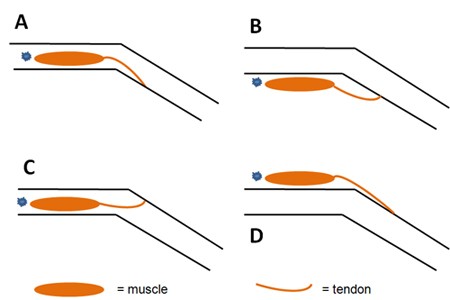The four most abundant elements in living organisms are:
A) carbon, hydrogen, potassium, and oxygen.
B) hydrogen, nitrogen, carbon, and silicon.
C) carbon, nitrogen, hydrogen, and calcium.
D) hydrogen, nitrogen, oxygen, and carbon.
E) carbon, hydrogen, nitrogen, and phosphorus.
D) hydrogen, nitrogen, oxygen, and carbon.
You might also like to view...
Sex differences in body growth are mediated by changes in growth hormone, insulin-like growth factor I and
A. thyroid hormone. B. estradiol and testosterone. C. prolactin. D. progesterone. E. cortisol.
The figure below represents a joint in the hind leg of a grasshopper. The exoskeleton of the leg is indicated by the two pairs of parallel black lines. A muscle that moves this leg is fixed to the skeleton at the end marked with a blue star. When the muscle contracts, it will pull on the tendon at its opposite end. Which configuration shows the most likely arrangement of the exoskeleton and a muscle that increases the flexion of this leg?
A. A B. B C. C D. D
How does water pressure one meter below the surface of a small pond compare to water pressure one meter below the surface of a large lake
What will be an ideal response?
Scientists have identified approximately ________ million species of organisms, but millions more are thought to exist
Fill in the blank(s) with correct word